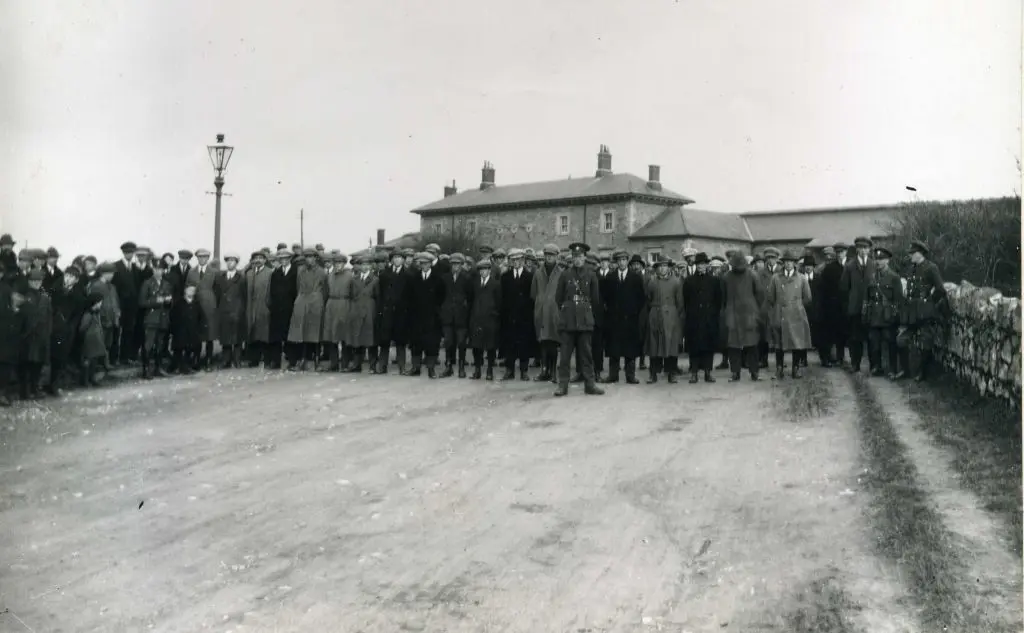
Previously, we charted the development of the IRA in Westmeath. Here, we discuss the ‘flying column’ that was formed in 1920.
As we have seen in an earlier post, the Irish Republican Army (IRA) had carried out a nationwide operation during Easter 1920, destroying over 300 buildings, such as abandoned Royal Irish Constabulary (RIC) barracks, courthouses and tax offices. These attacks were the first military operation undertaken by many IRA units and they marked a pivotal moment in the War of Independence.
The Westmeath IRA contributed to that wider operation by burning police barracks in the county and, three months later, it attacked the manned barracks at Streamstown. Although the police quickly repulsed the attack, it demonstrated that the IRA in Westmeath was becoming more confident and more active. In response to this growing threat, the police evacuated many barracks, withdrawing to more easily fortified buildings in towns such as Athlone, Mullingar, Kinnegad and Castlepollard.
According to Henry O’Brien, a leading member of the IRA in Athlone, the removal of police barracks and patrols from large parts of the county ‘was a great boon as it gave the Volunteers practically unrestricted movement in the area.’ The IRA in Westmeath took advantage of this relative freedom by acting as a police force in place of the RIC, especially in rural areas. This development, as we shall see in a subsequent post, was also linked with the arrival of the Dáil court system in the county.
Indeed, according to Patrick McCabe, a leader of the IRA in Mullingar, ‘the main work being carried out by the Volunteers at this time was police-work.’ In the Athlone Brigade area it was a similar story. Henry O’Brien wrote: ‘The duty of police-work threw a huge amount of work on the Volunteers … but an advantage gained from this duty was that it gave the Volunteers work to do and made them realise that they were a useful force and so improved morale.’ O’Brien’s words are a testimony to the fact that many, probably most, of Westmeath’s IRA volunteers were generally inactive during the period from the beginning of 1919 until the summer of 1920.
The British government, inevitably, made efforts to reassert its control of Ireland. On 9 August 1920, it introduced the Restoration of Order in Ireland Act (ROIA) which, among other powers, gave Dublin Castle and the Crown forces the right to court martial and intern civilians. The ROIA led to the arrest of many IRA volunteers and forced many others to go ‘on the run’. These volunteers banded together and formed the first flying columns, becoming elite units within the IRA. Some of the flying columns were very effective in their use of guerrilla warfare against the Crown forces, becoming famous during and after the War of Independence.
The first flying columns were local initiatives rather than a result of an order from IRA General Headquarters (GHQ). During the War of Independence, IRA GHQ had little direct control over brigades in the countryside although it quickly grasped the possibilities that flying columns offered for hit-and-run warfare against the Crown forces. During August 1920, it encouraged brigades throughout the country, including those in less active areas such as Westmeath, to form such units.
By late summer 1920, the IRA in Westmeath contained two brigades, one centred around Athlone, the other around Mullingar. It was the Athlone Brigade that formed a flying column, numbering about fifteen men, mostly officers who were ‘on the run’. The column was led by James Tormey, a 21 year old veteran of the British army, one of at least five ex-British soldiers in the column. The group had, Henry O’Brien recalled, only ten service rifles with about twenty rounds each.
In 1974, the historian Liam Cox interviewed two unnamed members of the Athlone-based flying Column. The two men provided Cox with the names of the column’s volunteers, as they remembered them. They were Seamus O’Meara, Harry [Henry] O’Brien, Joe Kennedy, George Manning, George Adamson, James Tormey, Con [Thomas] Costello, Tommy Claffey, Paddy Claffey, Frank Egan, Ned Johnson, Mick Nestor, Dick Bertles and Bill Casey. They added that the flying column was accompanied by ‘two or three unarmed scouts of whom John Hogan of Moate was one.’ There was one other member of the column whose name they could not remember but who was an ex-soldier in the British army. In addition to the unnamed volunteer, at least Adamson, Tormey, Tommy Claffey and Casey had previously served in the British army.
The IRA in Westmeath, as elsewhere in Ireland, would now make a more concerted effort to disrupt the activities of the RIC and the British army. The Crown forces would respond by targeting both the IRA and the civilian population. In later posts, we will discuss the activities of the flying column and the Crown forces, as well as Westmeath’s experience of the next, much bloodier, phase of the conflict.
Bureau of Military History Brigade Activity Reports; Bureau of Military History Military Service Pension Collection; Bureau of Military History Witness Statements; Freeman’s Journal, Irish Independent, Irish Times, Westmeath Independent and Westmeath Examiner. For more detail, see: Liam Cox, Moate – County Westmeath: A History of Town and District (Athlone, Alfa Print Ltd, 1981); and Ian Kenneally, ‘The War of Independence in Westmeath’ in the Journal of The Old Athlone Society, 2013.
Content Last Updated/Reviewed: 05/10/2020